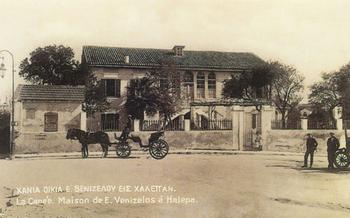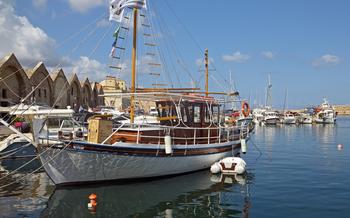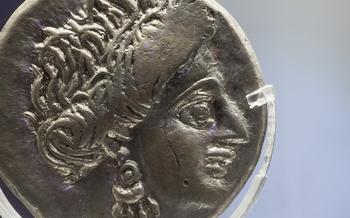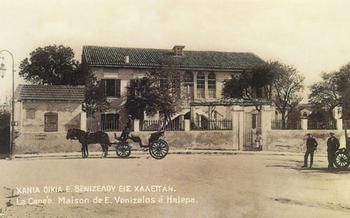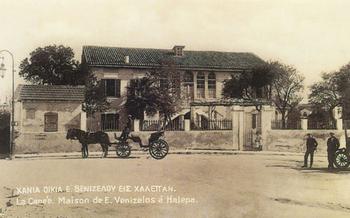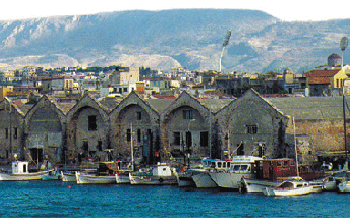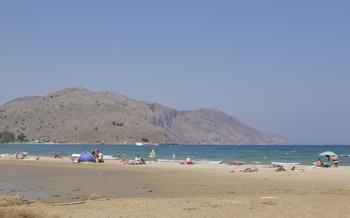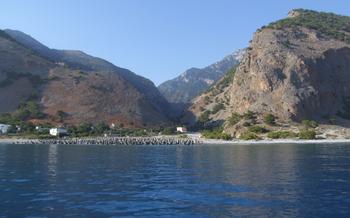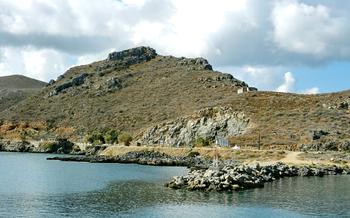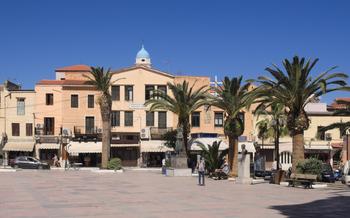
Venizelos Graves
- Historical Significance
- Location and Accessibility:
- Architectural Features
- Historical Context
- Visiting Hours and Admission
- Guided Tours
- Things to See and Do
- Tips for Visitors
- Photography and Videography
- Accessibility for Disabled Visitors
- Educational Programs
- Preservation and Conservation
- Nearby Attractions: Exploring the Treasures of Chania
- Local Cuisine and Restaurants
- Insider Tip: A Hidden Gem Awaits
Historical Significance
The Venizelos Graves, located in the Akrotiri Peninsula of Chania, Crete, hold the remains of two of Greece's most prominent political figures: Eleftherios Venizelos and his son, Sofoklis. Eleftherios Venizelos, often referred to as the "Father of Modern Greece," was a visionary statesman who played a pivotal role in shaping the course of Greek history during the early 20th century. His son, Sofoklis, also served as a distinguished politician and diplomat, continuing the legacy of his father. The graves serve as a poignant reminder of their remarkable contributions and the profound impact they had on Greece's political landscape.
Eleftherios Venizelos, born in 1864, rose to prominence as a charismatic leader who championed Greece's modernization and integration into the European political arena. His progressive policies and diplomatic skills earned him widespread admiration and respect. During his tenure as Prime Minister, he implemented significant reforms, including the establishment of the Cretan State and the Balkan Wars, which ultimately led to the expansion of Greek territory. His vision for a strong and independent Greece resonated with the nation, and he remains a revered figure in Greek history.
Sofoklis Venizelos, born in 1894, followed in his father's footsteps, dedicating his life to public service. He served as a diplomat and politician, representing Greece in various international forums. Like his father, he was known for his diplomatic acumen and commitment to promoting Greece's interests abroad. His untimely death in 1964 cut short a promising political career, but his legacy continues to inspire future generations of Greek leaders.
Location and Accessibility:
The Venizelos Graves are situated on a hilltop overlooking the city of Chania, offering breathtaking panoramic views. To reach the graves, visitors can embark on a scenic 15-minute walk from the city center, passing through charming streets and alleys. Alternatively, they can opt for a leisurely 5-minute drive, following the signs leading to the site. Once there, ample parking is available for visitors' convenience.
Nearby landmarks include the Old Venetian Harbor, a picturesque waterfront area with numerous restaurants, cafes, and shops. Visitors can also explore the Chania Archaeological Museum, which houses a vast collection of artifacts from the region's rich history.
Architectural Features
The Venizelos Graves are renowned for their unique architectural design, which blends classical Greek elements with modern influences. The graves are constructed from white marble, a material often used in ancient Greek architecture. The main feature of the graves is a large, domed structure supported by four columns. The dome is adorned with intricate carvings and sculptures, depicting scenes from Greek mythology and history. The graves also feature a number of smaller, individual markers, each dedicated to a member of the Venizelos family. The use of marble and the classical design elements create a sense of grandeur and solemnity, befitting the legacy of the Venizelos family. The artistic elements incorporated into the design, such as the sculptures and carvings, add a touch of beauty and symbolism to the graves.
Historical Context
The Venizelos Graves hold immense historical significance, serving as a testament to the lives and legacies of Eleftherios Venizelos and his son, Sofoklis. Eleftherios Venizelos, often regarded as the "Father of Modern Greece," played a pivotal role in shaping the course of Greek history. His unwavering dedication to democracy, progressive reforms, and national unity left an indelible mark on the nation's political landscape. Tragically, he passed away in 1936, leaving behind a legacy of transformative leadership. His son, Sofoklis, followed in his father's footsteps, serving as a distinguished politician and diplomat. However, his life was cut short in 1964 when he fell victim to an airplane crash. The deaths of Eleftherios and Sofoklis Venizelos were profound losses for Greece, and their graves stand as poignant reminders of their contributions to the nation's history.
Visiting Hours and Admission
The Venizelos Graves are open to the public daily from 8:30 AM to 3:00 PM, except on major holidays. Admission to the site is free of charge. Visitors are welcome to explore the grounds and pay their respects to the Venizelos family. Guided tours are available upon request, providing visitors with a deeper understanding of the lives and legacies of Eleftherios and Sofoklis Venizelos, as well as the historical significance of the graves.
Guided Tours
Venturing into the depths of history demands a knowledgeable guide to illuminate the intricacies of the past. Guided tours at the Venizelos Graves provide an unparalleled opportunity to delve into the lives and legacies of Eleftherios and Sofoklis Venizelos, as well as the tumultuous era that shaped their destinies. Led by experienced historians or local experts, these tours offer a deeper understanding of the graves' significance and their enduring impact on Greek history and politics.
Booking a guided tour is not only convenient but also highly recommended for those seeking a comprehensive and enriching experience. Through the captivating narratives and insights shared by the guides, visitors can gain a profound appreciation for the struggles, triumphs, and contributions of the Venizelos family. Whether you're a history buff, a curious traveler, or simply seeking a meaningful connection to the past, a guided tour at the Venizelos Graves promises an unforgettable journey through time.
To book a guided tour, visitors can contact the local tourist information center or inquire directly at the graves' entrance. Tours are typically conducted in several languages, ensuring that international visitors can also benefit from this immersive experience. Don't miss this chance to transform your visit into an educational and inspiring adventure, where the past comes alive and resonates with newfound meaning.
Things to See and Do
At the Venizelos Graves, visitors can explore the final resting place of two of Greece's most influential figures. The graves themselves are impressive structures, constructed from marble and adorned with intricate carvings. Visitors can take their time to admire the architectural details and learn about the symbolism embedded in the design.
Beyond exploring the graves, visitors can immerse themselves in the history of the Venizelos family and their impact on Greek politics and society. Informative plaques and displays provide insights into their lives and achievements. Visitors can also take advantage of guided tours, which offer a deeper understanding of the historical context and significance of the graves.
In addition to exploring the graves, visitors can stroll through the surrounding park, which offers panoramic views of the city and the sea. The park is a peaceful oasis, ideal for quiet contemplation or a leisurely picnic.
For those interested in further exploring the history of Chania, the Venizelos Graves serve as a gateway to other nearby attractions. The city is home to several museums, including the Archaeological Museum of Chania and the Maritime Museum of Crete, which offer a glimpse into the region's rich past. Visitors can also visit the Old Town of Chania, with its charming Venetian architecture and lively atmosphere.
Tips for Visitors
-
Comfortable Shoes: The terrain around the graves can be uneven, so it's advisable to wear comfortable shoes to navigate the grounds safely.
-
Hydration and Snacks: Visitors should bring water and snacks, as there are no food or beverage options available on-site.
-
Restrooms: Public restrooms are available nearby, providing convenience for visitors during their visit.
-
Respectful Conduct: As a historical and cultural landmark, visitors are encouraged to be respectful of the site and avoid any actions that may damage or disrupt the graves.
-
Photography Guidelines: While photography is permitted, visitors should be mindful of the rules and regulations regarding videography and photography at the site.
Photography and Videography
The Venizelos Graves offer a picturesque backdrop for photography and videography, allowing visitors to capture the beauty and grandeur of this historical site. However, it is important to respect the solemnity of the graves and adhere to the following guidelines:
-
Respectful Photography: Visitors are encouraged to take photos and videos for personal use, but they should do so in a respectful manner that does not disturb other visitors or detract from the peaceful atmosphere of the site.
-
No Commercial Use: The use of photography and videography for commercial purposes is strictly prohibited without prior permission from the relevant authorities.
-
Tripods and Equipment: Visitors are allowed to use tripods and other photography equipment, but they should be mindful of other visitors and avoid obstructing walkways or blocking the views of others.
-
Flash Photography: The use of flash photography is not permitted inside the graves or mausoleum.
-
Drones: The use of drones is not permitted at the Venizelos Graves due to safety and privacy concerns.
By following these guidelines, visitors can ensure that they capture their memories of the Venizelos Graves while respecting the site's historical significance and maintaining the tranquility of the surroundings.
Accessibility for Disabled Visitors
The Venizelos Graves are committed to ensuring accessibility for visitors with disabilities. The site features several ramps and elevators that allow wheelchair users and individuals with limited mobility to navigate the grounds and explore the graves. Tactile signage and audio guides are also available for visually impaired visitors, providing a comprehensive and inclusive experience. Visitors with disabilities can request assistance from the on-site staff, who are trained to provide support and ensure a safe and enjoyable visit for all.
Educational Programs
The Venizelos Graves are not just a historical site; they also serve as an educational resource for visitors of all ages. The foundation that manages the graves offers a range of educational programs and resources to enhance visitors' understanding of Greek history and the lives of Eleftherios and Sofoklis Venizelos. These programs include:
-
Workshops: The foundation organizes workshops and seminars on various topics related to Greek history and politics, with a focus on the Venizelos family. These workshops are led by historians, scholars, and experts in the field.
-
Lectures: Throughout the year, the foundation hosts lectures and talks by renowned speakers who share their insights on the life and legacy of Eleftherios Venizelos and his son. These lectures provide visitors with an opportunity to learn from experts and engage in discussions on Greek history.
-
Exhibitions: The foundation organizes temporary and permanent exhibitions that showcase artifacts, documents, and photographs related to the Venizelos family and their contributions to Greek history. These exhibitions offer visitors a deeper understanding of the family's role in shaping the course of Greece's political and social development.
To book educational programs or arrange for guided tours for students, visitors can contact the foundation directly. The foundation's website provides detailed information on upcoming events, workshops, and exhibitions, as well as contact information for making reservations.
Preservation and Conservation
The Venizelos Graves hold immense historical and cultural significance, making their preservation and conservation of paramount importance. Recognizing this, various efforts have been undertaken to protect and maintain the integrity of this revered site. Regular maintenance and restoration work are carried out to address any signs of wear or deterioration. Strict guidelines and regulations are enforced to prevent vandalism and damage to the graves and surrounding grounds. Visitors are encouraged to respect the site's sanctity by adhering to these guidelines and refraining from touching or leaning on the graves. By working together, we can ensure that the Venizelos Graves remain a well-preserved and cherished landmark for generations to come.
Nearby Attractions: Exploring the Treasures of Chania
Beyond the Venizelos Graves, Chania offers a myriad of captivating attractions that beckon visitors to delve deeper into its rich history and vibrant culture. Immerse yourself in the labyrinthine alleys of the Old Town, where Venetian and Ottoman influences blend harmoniously in the architecture and atmosphere. Marvel at the imposing Venetian harbor, a testament to the city's maritime heritage, and embark on a scenic boat trip to explore the mesmerizing coastline.
For a glimpse into the artistic soul of Chania, visit the Municipal Art Gallery, showcasing a diverse collection of paintings, sculptures, and ceramics by renowned Greek and international artists. Delve into the fascinating world of maritime history at the Maritime Museum of Crete, where exhibits narrate the island's seafaring traditions and its role as a vital crossroads of the Mediterranean.
Embrace the flavors of Crete at the Chania Central Market, a bustling hub of local produce, spices, and delicacies. Here, you can savor the freshest fruits, vegetables, and herbs, along with traditional cheeses, honey, and olive oil. Experience the vibrant nightlife of Chania by venturing into the charming streets of Splantzia, where lively bars and tavernas offer a lively atmosphere and traditional Cretan music.
Venture beyond the city limits to discover the breathtaking beauty of the surrounding region. Explore the Samaria Gorge, the longest gorge in Europe, and hike through its dramatic landscapes, encountering rare flora and fauna. Relax on the pristine beaches of Balos Lagoon, with its turquoise waters and pink-tinged sands, or embark on a scenic drive through the picturesque villages of the Akrotiri Peninsula, with its Venetian fortresses and panoramic views.
Local Cuisine and Restaurants
After a visit to the Venizelos Graves, indulge in the delights of Cretan cuisine at one of the many local restaurants and tavernas in the area. Sample traditional dishes such as "dakos" (barley rusks topped with tomatoes, feta cheese, and olive oil), "gamopilafo" (wedding pilaf with lamb or chicken), and "kalitsounia" (fried or baked pastries filled with cheese, herbs, or meat). Don't miss the opportunity to try fresh seafood, including grilled octopus, calamari, and red mullet, caught daily from the nearby sea.
For a truly authentic experience, head to one of the tavernas in the picturesque village of Theriso, just a short drive from the graves. Enjoy your meal in a charming outdoor setting, surrounded by olive groves and traditional stone houses. Many restaurants offer panoramic views of the surrounding mountains and the sparkling blue sea.
Insider Tip: For a truly unique culinary experience, try the "Sfakiani pita," a traditional pie made with mizithra cheese, honey, and cinnamon. This sweet and savory treat is a local specialty that you won't find anywhere else.
Insider Tip: A Hidden Gem Awaits
For those seeking a tranquil and picturesque spot, venture a short distance from the main graves to discover a hidden gem—the tomb of Pavlos Koundouriotis. This lesser-known grave, nestled amidst lush vegetation, offers a serene and intimate atmosphere. Capture the essence of this secluded retreat through stunning photographs, free from the hustle and bustle of crowds. Embrace the tranquility and immerse yourself in the serene beauty of this hidden treasure.
